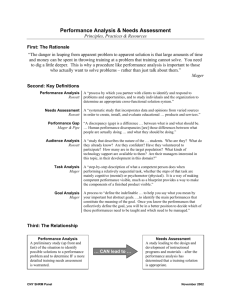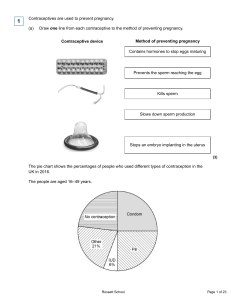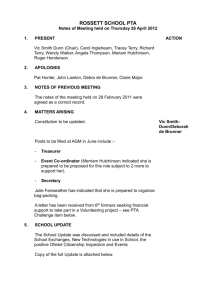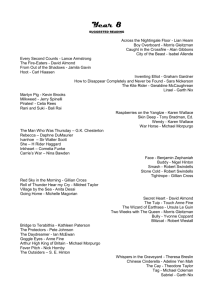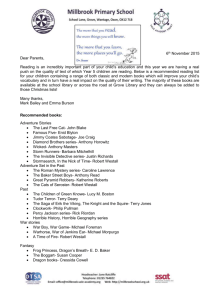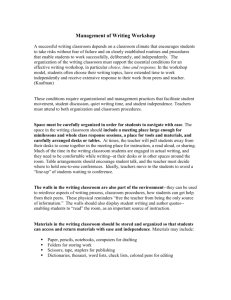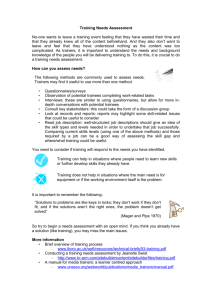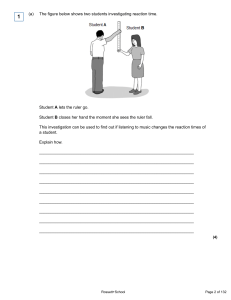Needs_Analysis - speakeasydesigns.com
advertisement
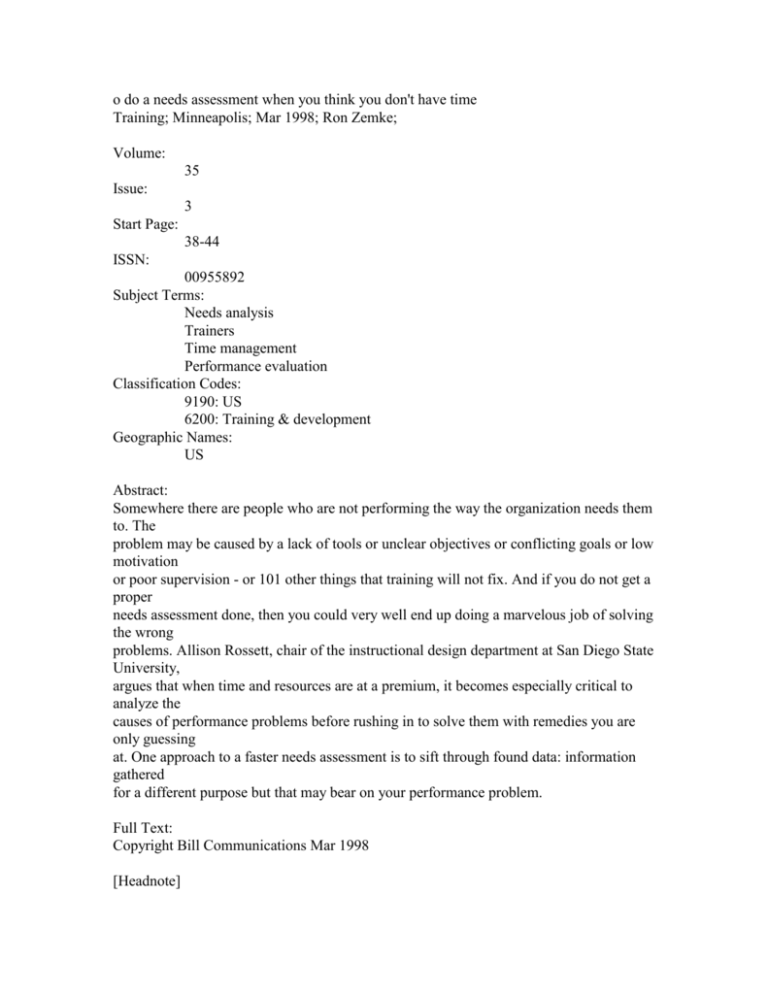
o do a needs assessment when you think you don't have time Training; Minneapolis; Mar 1998; Ron Zemke; Volume: 35 Issue: 3 Start Page: 38-44 ISSN: 00955892 Subject Terms: Needs analysis Trainers Time management Performance evaluation Classification Codes: 9190: US 6200: Training & development Geographic Names: US Abstract: Somewhere there are people who are not performing the way the organization needs them to. The problem may be caused by a lack of tools or unclear objectives or conflicting goals or low motivation or poor supervision - or 101 other things that training will not fix. And if you do not get a proper needs assessment done, then you could very well end up doing a marvelous job of solving the wrong problems. Allison Rossett, chair of the instructional design department at San Diego State University, argues that when time and resources are at a premium, it becomes especially critical to analyze the causes of performance problems before rushing in to solve them with remedies you are only guessing at. One approach to a faster needs assessment is to sift through found data: information gathered for a different purpose but that may bear on your performance problem. Full Text: Copyright Bill Communications Mar 1998 [Headnote] Yes, management wants that training course right now. But no, that isn't an excuse to deliver lousy training. Sometimes it seems everybody in the organization is screaming for training at once. Meyers in accounting wants you to create a course that will teach those dunderhead supervisors to manage within the confines of their allotted budgets. Peterson in operations wants you to hightail it to the Omaha plant and straighten out the shipping operation there: "Run that seminar on inventory control or something" were his exact words. Oh, and then there's the Lotus Notes introduction scheduled for the second quarter (the one you only found out about yesterday). And Mason from field sales just called to let you know she's bringing all her field managers to town in April and wants you to treat them to a program that will cover coaching, performance management, dealing with problem employees and selection interviewing. She has you slotted for four hours: "Four topics, an hour each. That ought to be enough, right?" Welcome to training in the '9os. And all the while, in the back of your mind, a little voice is saying: "Whoa! Slow down. You've got to sort out some things about these projects. They can't all be training problems. You've got to do a needs assessment." That voice is countered by another: "No! Don't drag your feet with that assessment stuff! We've gotta show 'em we're team players, with a `bias for action.' Ready, shoot, aim! Just do it!" Somewhere there are people who aren't performing the way the organization needs them to. The cause may well be that they can't pass consultant Bob Mager's famous Acid Test of Training Needs: They couldn't do the job if you held a pistol to their heads. They simply don't know how. Ergo, training is the solution to the performance problem. But it is at least as likely that the problem may be caused by a lack of tools or unclear objectives or conflicting goals or low motivation or poor supervision or insufficient feedback or badly defined standards-or iol other things that training won't fix. And if you don't, somehow, get a proper needs assessment donesome sort of dependable analysis that can tell you why there is a gap between the performance the organization requires and the performance that Meyers and Peterson and Mason are hollering about-then you could very well end up doing a marvelous job of solving the wrong problems. But from where you sit, your only viable option is to step up to the plate and take your swing at the ball, because that's all you have time to do. The Petersons of this world don't take kindly to "bureaucratic delays," and if you don't display a cooperative, gung-ho, can-do attitude these days, you can find yourself out of a job. The need for speed Classically, the term "needs assessment" has tended to connote a rigorous, elaborate, time-consuming, academic-style research project that delves deeply into the nature and causes of a performance problem. Trainers have always complained that such projects are hard to sell to impatient, penny-pinching line managers. But have today's demands for just-in-time training, instant culture change, and emergency overhauls in entire work processes placed such a premium on speed that any sort of needs assessment has become a luxury the business world can no longer afford? Not according to professor Allison Rossett, chair of the instructional design department at San Diego State University "Time pressures? That's an excuse. An alibi. Unless you're a mystic, how the heck else are you going to know what to do? There are just too many ways for performance to go astray to just assume you know or can `logic out' the solution." Indeed, Rossett argues that when time and resources are at a premium, it becomes especially critical to analyze the causes of performance problems before rushing in to solve them with remedies you're only guessing at. Roger Kaufman, director of the Center for Needs Assessment Programs at Florida State University in Tallahassee, insists that needs assessment is an absolute necessity if you are to stand any real chance of creating a relevant intervention-be it training, a change in procedures, or some other performance solution. "When there are gaps between current results and required results, you have to identify what the reasons are and spell out the alternative ways to get from here to there," Kaufman says. "The advice to do things `faster, better, cheaper' is good but incomplete. More than ever we have to be sure that we know whether what we are proposing is going to add value to the client." It is the need for speed that creates the tension between textbook visions of elaborate, painstaking research projects and the kind of needs assessment required for today's corporate warp zone. Dale Brethower, professor of psychology at Western Michigan University in Kalamazoo, puts the problem in context: "Needs assessment is still important, vital, to deciding the best way to close the gap between existing performance and the way it should be. What doesn't work today is to say, `Wait, we've got to do a lengthy needs assessment here.' That is perceived as slowing things down and not being part of the solution." Brethower and Rossett agree that if time is of the essence, some classic informationgathering techniques may have dubious value. "Surveys are too slow and the results usually too unclear," says Brethower. Likewise extensive behavioral observations, adds Rossett: "Watching people work is a long, laborious process. And today, when most of the interesting stuff goes on in the performer's head, it isn't all that productive." Faster-paced world or not, however, Kaufman and Rossett both question the extent to which those lengthy, old-style needs assessments ever existed outside the fantasies of textbook writers. Says Rossett, who has written extensively on the subject: "I'm not so sure a lot of people have ever done a complete needs assessmentfast or slow-in the sense of [a genuine analysis of particular performance gaps]. Plenty of people have indulged in aimless, habitual activities like sending out the annual needs survey around budget time, but that's hardly a real needs assessment. At best it's window dressing." What to do? If there ever was a heyday for needs assessment in the form of a lengthy and extensive research project, that day is gone. But since the need for needs assessment is still very much here, what alternatives does that leave us? Quite a few, actually. Christine Westall, a performance technology consultant with Hewlett-Packard in Cupertino, CA, confides that in her 15 years in training and development she has seldom had the luxury of conducting a textbooklike needs assessment. "I've never been successful at selling that [to management]," she says. "But I have been successful at getting out there and gathering some useful information. It may not pass muster as research, but it's good enough for what businesses are looking for within the time frames they can devote to a project and what they are willing to spend." As for those time frames, common sense suggests that the scope of the needs assessment should depend on the size of the problem you're trying to solve. "I have a series of questions I ask my clients about the nature of the problem and the impact of the problem on the business," Westall says. "If it seems to be a small, local matter or something that will only have a mild impact, I keep the information-gathering to a few hours of interviewing with the client and a few other managers. If I see a big concern or the possibility of major impact from solving the problem well, I use a [more elaborate] approach. I talk to a lot of people and gather a lot more information before I act." Rossett casts the issue in terms of organizational politics: "You need to be mindful of two things: the kinds of information you will need and the political realities. Let's say you have an important client who is pressing for speed. You convince [the client] that you need to do interviews with a number of peoplesay, 17 engineers who make presentations to customers-to see how opinions and approaches may vary. After six interviews you can tell that the variations are pretty minor. Well, stop interviewing. Tell your client what you've seen, and get on with forming a solution. It's not high risk at that point, and it shows the client you are sensitive to his need for action." Westall suggests that you sometimes can avoid looking like a foot-dragger simply by changing the order of your conversation with the client. When the manager says he needs a training program, don't tell him you have to do a needs assessment first. Instead, accept the training assignment, then study the performance problem and renegotiate the assignment as information emerges. For instance, Westall says, a senior manager once said he needed her to conduct a fourhour program for new managers on how to act as a "coach" to subordinates. Rather than argue the wisdom of the assignment, Westall simply accepted it and began looking for the underlying causes that led to the request. "I interviewed him and other managers, and as the picture of what seemed to be the real problem emerged, I went back and renegotiated the intervention," she recalls. In the end, Westall learned that it wasn't a lack of skills, knowledge or motivation that was impeding managers from coaching their employees; rather, the problem was conflicting priorities. The session she eventually ran focused on creating ways to make sure there would be time available to do coaching. "I've found," Westall says, "that if you go to a client and say, `Look, I've got this data, and it's telling me something different, and we need to take another look at what we're doing, because you aren't going to get value out of your money,' most of the time they listen-and they're responsive." It's no accident that the message to which those clients are responsive is couched in direct, straightforward language. Kaufman speculates that needs assessment in general would be far easier to "sell" if trainers would only talk about it in plain English. "My bias is to make it simple," he says. "Talk about it the way the [total quality management] and continuous-improvement people do." In fact, Kaufman says, you can describe not just needs assessment but the whole performance-improvement process in TQM-like terms, as a six-step procedure: i) Identify the problem; 2) determine the solution requirements; 3) identify alternative means to get from here to there; 4) select a solution on the basis of cost and consequences, and implement it; 5) determine the effectiveness and efficiency of the solution; 6) revise as required. "Now, anybody can understand that and see the value," he says. Quick time Another approach to faster needs assessment is to sift through "found data": information gathered for a different purpose but that may bear on your performance problem. "Every time you have to go out and gather fresh data for needs assessment, it costs a lot of time and money," Rossett says. "You can save both by searching through error data, sales data, customer-complaint letters, grievances, exit interviews-whatever information you can dig up that is routinely kept for some other purpose that can potentially [shed light on] your project." A third time-saving approach Rossett recommends is to use the World Wide Web. She has found it helpful to conduct something akin to an electronic Delphi study. "We were recently looking at the health-education needs of university people across the United States," she says. "We basically set up a listserv where we posted questions, synthesized the answers, asked more questions, posted more answers, and in general acted as the host for a very specialized listserv." The eightweek, iterative, electronic Q-and-A session resulted in a Web site called The College Health 2000 Collaborative Workspace. The site lets users share resources, opinions and information on trends. It also publicizes events and seminars of interest to university students pursuing careers in health care. Rossett adds an important addendum to the discussion of how to accommodate needs assessment to contemporary demands for high-speed, low-folderol analysis. Call it organizational scanning-or simply being connected. "I believe," she says, "that if trainers in an organization just pay attention, they will be able to anticipate what's going to be asked for and be prepared for it. Was anybody taken by surprise by Windows 95 or the call for diversity seminars? They shouldn't have been. If you are the manager of sales training and you're paying any attention at all to your business and your specialty, how can you be taken aback when someone calls you and says they want to discuss training people to use sales-call automation?" In short, needs assessment isn't necessarily an event with a start and stop switch. It is the process of being engaged in your business and your craft. Above all else, and beyond any particular informationgathering technique, Rossett says, "needs assessment is a state of mind, a state of inquisitiveness." Rapid analysis Brethower, who contends that most performance-change projects are hurry-up affairs, recommends an on-the-fly approach to needs assessment that he calls rapid analysis. You must begin, he says, with the philosophy that the most effective and efficient training is always that which is "just-in-time, just enough, and just for me," The technique itself is to create a "rapid prototype" of a training program, "evaluating and revising as you implement and learn more about the problems." As an example, Brethower points to a project conducted by his wife, Karolyn Smalley, formerly a manager of H RD with a large direct-sales company in Michigan. "The senior account managers of her corporation wanted to be much wiser about the financial aspects of their business," he says. "The presenting problem was to get them much further into the financial aspects of their business and their customers' businesses than a [standard] consultative-selling approach required them to do." The challenge was to convince the account managers that they could be successful acting more like real consultants to their clients' businesses, as opposed to using their standard tactics. Smalley needed to get them to open up and look at the details of this new approach before rejecting it out of hand. Smalley's tactic, says Brethower, was first to find the few account managers who already were adept at getting their customers to let them look at their financial data and make suggestions based on what they saw. In other words, she sought out exemplars of the performance that the company wanted all the account managers to exhibit-a traditional move in the performance-improvement game. But rather than using the exemplars' savvy to build an idealized "model" of the new, improved account manager-a model she would then try to sell to the reluctant troops-Smalley instead brought all of the account managers together in a series of forums. There, they could talk about the new approach and the exemplars could share their experiences and insights. This approach has advantages that go beyond mere speed, Brethower says. "You analyze the problem and bring together the expertise to solve it, in this case by having people share that expertise with each other. You avoid the risk of packaging the wrong information, and they learn just what they need to know from each other through a focused dialogue." Had she followed the traditional needs-assessment model, where analysis of the problem and development of a solution are seen as separate activities, sometimes even done by different individuals, Smalley would have run a far greater risk of building a solution that no one liked and that didn't solve the performance problem. The software crash course One of the most challenging assignments a training department can face is the out-oftheblue announcement that a new product or service or system or software package is about to go online, and 15 gazillion people will have to be trained on it-beginning next week. The urgency seems to negate any possibility of needs assessment. But does it? Brethower recommends an approach that begins with a clear-eyed view of the situation: "All those people are going to be doing something specific with that software. And they most likely are using some other software to accomplish that same end right now. So the task isn't to teach them their jobs or the new software from the ground up. It is a more manageable task: to help them convert what they're doing to a new system." Therefore, Brethower suggests, make the training a straightforward conversion exercise led by a seasoned instructor and a subject matter expert. "If you operate like that, then you [the instructor] and the software expert are focused on converting them to the new system, not teaching everything there is to know about the new software," he says. Along the way, he adds, you'll learn what the troublesome learning areas are for the trainees, so you can keep improving the crash course in subsequent sessions. The more vital training becomes to an organization's success in the marketplace, the more important it is that needs assessment be a part of the training process. If having a well-trained, up-tothe-minute work force is a competitive strategy in your organization, then the training needed to bring that work force to peak performance must be both effective and efficient-precise and timely. Equally precise and timely must be the analysis you do to determine whether training is the right solution for a given performance problem and, if so, exactly what that training needs to address. * [Author note] RON ZEMKE is senior editor of TRAINING. zemke@aol.com Reproduced with permission of the copyright owner. Further reproduction or distribution is prohibited without permission. Other formats for this document:

